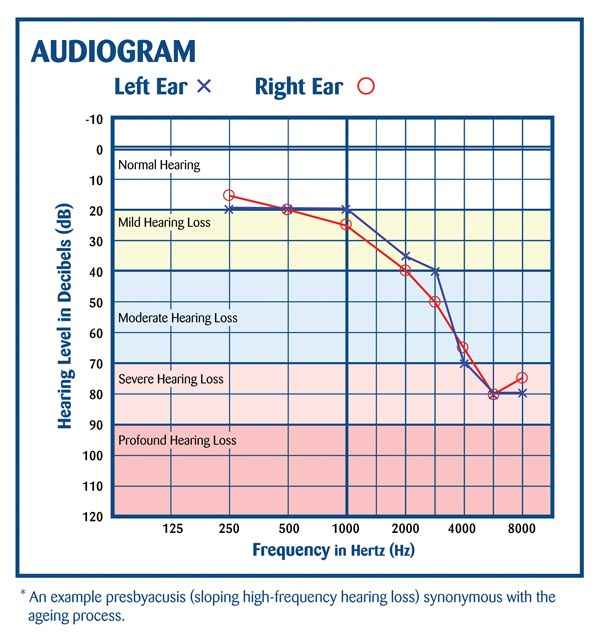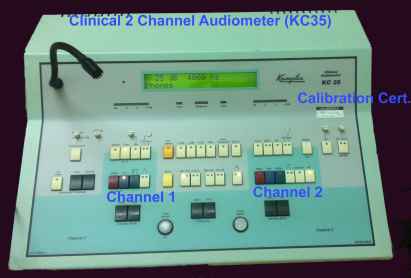- Audiometry
- Tympanometry
- Adv Audiology
- Vestibular
- Allergy Testing
- Tinnitus
- Hyperacusis
- Misc. Audiology
- Clinical Photography

In its simplest form
a hearing test (audiogram) is a method of investigation to assess the
sensitivity of a person's subjective hearing threshold by presenting
them with short duration pure tones of differing frequencies until they
can no longer hear them.
Screening Audiometry
is a fairly simple form of Clinical Audiometry that can be performed by
non-audiologists such as school nurses or health visitors to assess
whether the subject/patient has acceptable hearing thresholds. If they
do not then they should be re-tested and if they still fail to obtain
an acceptable hearing threshold then they should be referred for
clinical audiometry.
Screening
Audiometry
Sound Transmission
The function of the ear is to convert airborne sound waves into action
potentials in the auditory nerves for onward transmission to the
cortex. The tympanic membrane responds to the sound pressure waves by
moving in and out, thus acting as a resonator reproducing the
vibrations of the sound source. When the sound stops the drum almost
stops immediately being very critically damped. The movement of the
drum is transmitted to the malleus, which rocks on its axis and
transmits the movement through its short process to the incus. Movement
of the incus is transmitted to the head of the stapes in such a way
that the stapes footplate moves to and fro, like a door, hinged at the
posterior edge of the oval window. The ossicles thus act as a lever
system, converting the resonant vibrations of the drum into movements
of the stapes footplate against the perilymph fluid in the cochlea.
This system increases the sound pressure that arrives at the oval
window in two ways. Firstly there is a slight leverage advantage, due
to the arrangement of the ossicles that increases the force 1.3 times.
Secondly the area of the tympanic membrane is much greater than that of
the oval window. These combined effects produce a transformation ratio
of 22:1.
In Summary:
- Sound
waves impinge on the drum causing it to vibrate.
- Ossicles
vibrate as a unit.
- Stapes
moves in and out of the oval window.
- Sound
waves are transmitted along scala vestibula in the perilymph.
- Short
waves (high frequencies) act at the base of the cochlea.
- Long
waves (low frequencies) act at the apex of the cochlea.
- The
wave is transmitted across scala media to scala tympani.
- Waves
travel along scala tympani.
- Effect
of wave on round window causes it to bulge outwards.
- Wave
motion distorts Reissnerís membrane and basilar membrane thus
stimulating the organ of hearing (Organ of Corti)
- Impulses
from hair cells are then transmitted along the cochlea nerve.
Equipment
To perform a hearing test an audiometer is required. These come in many
shapes and sizes but in its simplest form the audiometer consists of:
- An
oscillator producing pure tones of a frequency that can be varied,
usually from 125 - 8000 Hz in one half-octave steps.
- An
attenuator, which alters the intensity of the sound, delivered
usually in 5dB steps (volume).
- A
speaker that delivers the sounds to the ear (headphones).
 Normally other controls will
include, an interrupter, which is a noiseless switch that allows the
sound to be presented, and a selector switch to deliver the sound in
either the left earphone or right earphone. These are the basic
controls of the simplest audiometer and are only adequate for screening
purposes. Clinical audiometers usually have two channels and are able
to 'mask' (see below) and additionally have a bone conductor.
Normally other controls will
include, an interrupter, which is a noiseless switch that allows the
sound to be presented, and a selector switch to deliver the sound in
either the left earphone or right earphone. These are the basic
controls of the simplest audiometer and are only adequate for screening
purposes. Clinical audiometers usually have two channels and are able
to 'mask' (see below) and additionally have a bone conductor.
All Audiometric equipment comply with (BS) EN 60645, calibrated in
accordance with (BS EN) ISO 389 and Audiometric Test Methods performed
under (BS EN) ISO 8253-1:2010 standards, these are all European
standard too.
Clinical Audiometry -
Pure Tone Audiogram (Hearing test)
 In
the clinical situation additional features are essential if more
sophisticated testing is to be undertaken. One of these includes
masking or a spectrum of noise that can be delivered to the ear not
under test in order to prevent it from receiving loud signals intended
for the test ear. Usually masking is available as wide band where the
sound consists of all frequencies and is always used in speech
audiometry, or narrow band where the noise frequencies are filtered to
include only those frequencies around the test frequency. This latter
type of masking is usually used in pure tone testing where the
frequency of the noise automatically alters with the frequency of the
test signal. A masking attenuator similar to a pure tone attenuator and
graduated in the same way governs the masking output.
In
the clinical situation additional features are essential if more
sophisticated testing is to be undertaken. One of these includes
masking or a spectrum of noise that can be delivered to the ear not
under test in order to prevent it from receiving loud signals intended
for the test ear. Usually masking is available as wide band where the
sound consists of all frequencies and is always used in speech
audiometry, or narrow band where the noise frequencies are filtered to
include only those frequencies around the test frequency. This latter
type of masking is usually used in pure tone testing where the
frequency of the noise automatically alters with the frequency of the
test signal. A masking attenuator similar to a pure tone attenuator and
graduated in the same way governs the masking output.
A Bone conductor is essential if cochlea function is to be assessed.
This consists of a vibrator on a headband that can be placed on the
mastoid bone. Pure tones are directed through the conductor as 'Force'
rather than sound pressure. Masking for bone conduction is usually
through an insert earphone or headphone and again narrow band noise is
used.
Pure Tone Testing
The purpose of pure tone testing is to determine the quietest possible
sound that the patient can hear at a variety of frequencies. With this
in mind the test technique merely achieves this end in the quickest and
most accurate way. Most patients tested can be done so in a set pattern
and valid results will be obtained, however no two individuals are
alike or will respond in the same way to a method of testing, this
particularly applies to children, elderly patients and malingerers. For
this reason the test technique below is purely as a guide that can be
adapted to suit a particular situation.
Method: Instruct the patient as to what is required
of him. Explain that he will hear a series of sounds, each and every
time that he hears the sound he is to signal that he has heard it.
Sometimes the sounds will be loud and sometimes very faint but every
time he hears the sound he is to indicate. One ear will be tested at a
time, the better ear first. With children the above method may have to
be repeated more than once, it is no use beginning the test until the
subject knows what is expected. Fit the headphones over the ears
ensuring that the pinna is closed completely with the red earphone over
the right ear. If the subject wears spectacles remove them.
Technique: The tones are first presented at an
intensity that the patient can hear well in order to give a little
practice in the technique. The intensity is then reduced in 10dB steps
until the subject ceases to signal that he can hear the sound. We can
assume at this stage that the hearing threshold has been passed. The
sound intensity is then increased in 5dB steps until the subject again
signals that he has heard it. Again the sound is decreased in 10dB
steps and increased in 5dB steps. This procedure is repeated until the
subject consistently responds to one intensity and nothing at a lower
intensity. This value can then be recorded as the hearing threshold for
that one particular frequency. The next frequency is then tested in the
same way, although it is not now necessary to give too loud a starting
signal, as the subject should now be aware of what is happening. If the
subject fails to hear this starting frequency increase the intensity by
20dB.
Protocol: Normally testing starts at 1000Hz and
progresses to the highest frequency then drops to 500Hz and progress
down to the lowest frequency. The better ear is always tested first, if
neither is better as a matter of course the right ear is tested first.
Tone presentation should never be at regular intervals, even the most
honest subject finds it difficult to resist the temptation to signal
when he thinks a tone is due if the tester has been presenting the
tones at regular intervals.
As pointed out earlier the individual patient will dictate the method
of testing, for instance a very young child will rapidly get bored
listening to hundreds of sounds. It is far better to get reliable
results of three frequencies on each ear than a complete audiogram that
is hopelessly inaccurate at all frequencies. So a better method would
be to test one ear at 1000Hz then change ears, then test 3000Hz in both
ears and so on. Elderly patients are usually tested easily when a
slower sequence of presentations is used. Their responses are not as
quick as younger patients and rapid tone presentations should be
avoided. They usually like to be quite sure that they have heard the
tone before signalling so it may be necessary to repeat the tone a
couple of times at the same intensity.
Psychogenic hearing losses (non-organic or hysterical) can sometimes be
very difficult to detect but usually the tester should get some idea
that all is not as it should be in the normal routine test. Again as in
testing children it is no use recording threshold levels that are
untrue without making some comment on the bottom of the audiogram. Some
of the signs that all is not well include inconsistent responses or
responding to the initial tone and using this as their threshold and
not responding to any lower intensity. Certain types of patient seem to
be prone to psychogenic losses particularly adolescent girls, unhappy
servicemen (usually junior ranks) and service personnel due to leave
the Forces. Another group is children but particularly those who have
been subjected to a lot of audiometric testing and seem to thrive on
the extra attention that a hearing loss brings. Often there is no
apparent reason for psychogenic loss. Sometimes the patient will
produce illogical responses because he does not know what is expected
of him.

